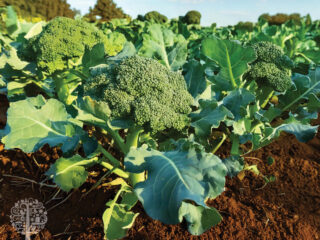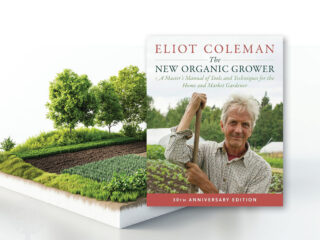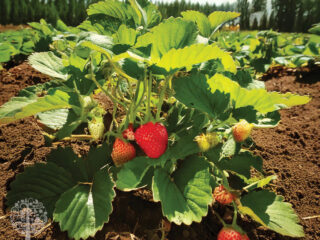Crop Rotation, Interplanting, and Companion Plants for IPM
In this edition, we explore how organic growing methods and living soil can help protect against pests and pathogens in the garden by strengthening the immune system of plants through their good health. Starting with a bustling soil microbiome is crucial. However, cultural practices like crop rotation and intercropping may also be employed as integrated pest management (IPM) strategies, especially for market gardeners. Here are a few helpful tips and some acclaimed resources for further reading.
Proper Planning
The planning phase of any garden is imperative to its success. This means mapping beds and assessing timing for frost dates and harvest, sun requirements, drought tolerance, nutritional needs, appropriate pairing, and, eventually, rotating crops.
Crop Rotation
One of the most interesting practices I’ve learned is the rotation of broccoli and strawberries for IPM. The insect-repellent nature of the brassica’s sulphur residue in the soil can protect the vulnerable berries against disease. This is one example of the synergistic relationships of plants and their ability to assist one another through biochemical signalling and biodiversity.


Interplanting
Intercropping or interplanting is the practice of planting different species of crops in proximity to maximise productivity based on complementary characteristics. Examples include the interplay of light and heavy feeders or taproot and fibrous root systems.
The best farmer I know of using this method is Jean-Martin Fortier – a Quebec farmer who intensifies the productivity of small plots of land, 2.5 acres or less. He educates farmers about strategic interplanting to maximise yield and space in the backyard market garden. Fortier wrote the popular 2012 handbook, The Market Gardener, A Successful Grower’s Handbook for Small-scale Organic Farming, and stated therein that he follows the teachings of Eliot Coleman – an innovative American farmer also worth checking out.
In his book The New Organic Grower, A Master’s Manual of Tools and Techniques for the Home and Market Gardener, Coleman calls crop rotation a good example of an ages-old dependable farming practice.
“To my mind, crop rotation is the single most important practice in a multiple-cropping programme,” he writes, including fertilisation and pest control. Coleman does not encourage the use of pesticides of any kind because “the systems of the natural world are elegant and logical.” And his reasoning? “Plants only become susceptible to pest attack when they are stressed by inadequate growing conditions.” Pests and disease then become markers for cultural practices that need improving.


A Multi-Pronged Approach
Step one in organic gardening IPM is keeping your soil as healthy, humus-rich, and microbially robust as possible. Step two is strategically using cultural practices for productivity, plant health, and IPM.
The rotation of broccoli and strawberries can help reduce specific pathogens, such as Verticillium fungi, that cause wilt in strawberries. The sulphur from broccoli and other Brassicas repels fungi and mould in the soil, and the crop residue leftover from broccoli is a biofumigant, similar to how mustard is used as a cover crop for disease suppression.
Overall, it’s good practice to rotate crops from different families because those from the same family possess the same susceptibilities. It’s important to note that some families can be prone to the same diseases, such as Rosaceae (strawberries) and Solanaceae/Nightshades (tomatoes), which are susceptible to Verticillium wilt.
Rotating crops with intention also replenishes minerals in the soil. A classic example of this is the rotation of corn and beans. Corn is a heavy nitrogen feeder, and beans or legumes are nitrogen fixers.
Moreover, planting non-host plants can resist enabling the spread of pests and disease. For example, corn rootworms can be controlled by rotating non-host/pest-resistant crops like soybeans and broadleaves. However, soybeans are susceptible to white mould, and corn is not. In addition to the complementary nitrogen rotation, which strengthens plants through nutritional needs (indirect IPM), corn and soy also make excellent rotation candidates as a direct defence against some pests and diseases.


Companion Planting
Companion planting, a version of intercropping, can also be used for IPM. Some flowers, like marigolds and nasturtiums, are reputed to repel nematodes and other pests while attracting predatory insects that prey on them. Nasturtiums can also help keep caterpillars away from cabbage. These are trap plants or crops. Nettles, as trap plants, can lure aphids away from other plants and attract the ladybugs (AKA your garden’s SWAT team).
When grown in the same garden bed, stinging nettle can increase the production of volatile oils in herbs in the Lamiaceae family, such as mint or basil. Cool, eh?
Prevention is Key
We’ve heard the adage “prevention is the cure” for people, which also applies to plants. Focusing on soil health and biodiversity in the garden, coupled with practices like crop rotation, companion planting, and trap plants, makes a powerful toolkit based on traditional agricultural wisdom. For physical tools and barriers, try row covers and protective netting.
Read Garden Culture Magazine. Study Coleman, Fortier, and many other farming pros and start practising for yourself. Indulging in the many educational tools available means working smarter in the garden and leveraging strategy hacks instead of chemical bypasses.




